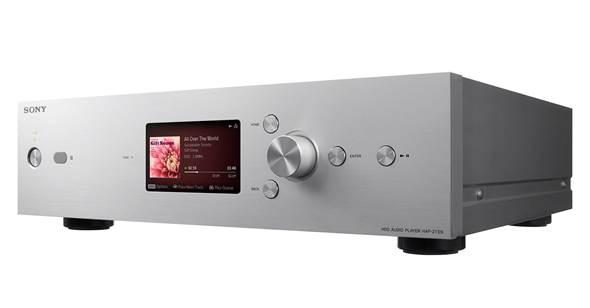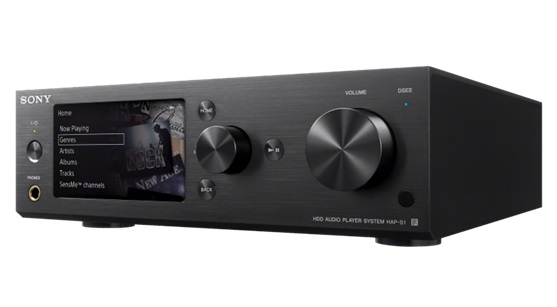Before you use the Sony in earnest, you’ll
have to hook it up to your home broadband network; there’s a choice of wired or
wireless, with a built-in antenna for the latter – no nasty stubby plastic masts
hang out from behind. Migrating music from your computer is done via Sony’s HAP
Music Transfer software (downloadable from the Support section of the Sony
Europe website), which runs on Windows or Mac and automatically copies all your
tunes to the HAP-S1’s hard drive via your home network. Usefully, it does this
in the background, so I am able to play music from the hard drive, or any other
source while it dutifully downloads my many files.
Being a hard disk-based system, it gives
instant access – there’s no lag between the track you choose and when it starts
playing. Also, you don’t get dropouts as it isn’t subject to network glitches,
and your computer can remain switched off while you’re playing music. I find
that it works so well in practice that I’m surprised more manufacturers haven’t
done it. My only observation would be that it would be great to be able to
record directly from an analogue source, so that you can archive your LPs or
tapes too. But you can, of course, record LPs on your computer, which the Sony
will automatically copy then play.

The
S-1 features Sony’s Digital Sound Enhancement Engine
The S-1 features Sony’s Digital Sound
Enhancement Engine, which is designed to make low bit-rate files sound more
palatable, and to “restore missing data from compressed audio”. In truth,
though, it does not do precisely this – rather, it guesstimates what should be
in the upper part of the audio band, and also what was in the tail end of the
waveform that was chopped off by the MP3 or AAC compression algorithm, and adds
it to the music file. A nice feature to have, but ideally audiophiles should
stick with the original hi-res music files rather than trying to magic them
better via clever DSP!

The
HAP-S1 gives instant access – no more lag
Sony products are always models of ergonomic
excellence, and the HAP-S1 is no exception. The large right hand volume knob is
easier to use than an up/down button, and the selector knob to the left works
well with the colourful display. In use, it is easier to operate than any
network music player – it functions more like an ‘instant CD player’ than a
computer audio product, old school and none the worse for it!
Sound quality
Auditioning starts via its analogue and
digital line inputs, to gauge the amplifier section. This proves to have a
smooth, detailed sound that is nicely animated – although tonally slightly thin
on Freeez’s Southern Freeezvia LP. There is also some splashiness to the treble
and some lack of air and space, although it is pleasant enough. The digital
input is better, with a cleaner and more open sound, one that is very enjoyable
in its way. It proves to be fun with a big-hearted, animated sort of character,
and gets on with the job in a satisfying manner. The HAP-S1 also features a
built-in internet radio tuner, using vTuner, and this works well, despite the
depressingly low bit-rates used by the broadcasters. Still, it’s fine for
background music and handy extra functionality.
Moving to the delights of the unit’s internal
hard drive, it serves up the best sound I’ve heard so far from some of my
hi-res PCM files; Wings’ Band on Runis very detailed and clean, with lots of
atmosphere and a natural rhythmic flow. Dynamics are good, and when fed with
beautifully rich source material such as Kate Bush’s Snowflakein 24/96, it
gives a fine account of Kate’s piano work. REM’s Texarkanaat 24/192 is great
fun, with oodles of power and impressive dynamics. With hi-res files it makes a
very nice noise then, but you are always aware of a slightly opaque midband, and
a sense of the music being processed.

It’s
fine for background music and handy extra functionality
Dropping the bit-rate down provides a chance
to try the unit’s DSEE facility; a 256kbps MP3 of Jon and Vangelis’ I Hear You
Nowis nice enough. With the Sony system switched off, the HAP-S1 catches the
track’s warm and fluffy sound, and makes a decent enough job of the rhythms
too. Switched on, it really does improve things, adding some air and space to
the hi-hat cymbal work; the bass sequencing is more distinct and tuneful, and
the lead synthesiser line carrying the melody has better resolved leading
edges. Jon Anderson’s voice is a little less muffled, but fractionally brighter
and more sibilant, however. Overall, I feel this to be a worthwhile facility, especially
on lower bit-rate MP3s, although contrary to what Sony might claim, it’s not
able to make a sonic silk purse out of a sow’s ear.